While hellebores grow best in southern parts of Australia, it is possible, with enough shade and irrigation, to grow them successfully in any part of the country. They are gorgeous plants that add interest in challenging months and can be found in such a wide range of flower colours that it’s hard to think of a garden that they wouldn’t suit.
For everything you need to know on these easy-to-care-for plants, that are slightly picky about positioning, follow this in depth guide to planting and growing them in Australia, as well as some of our favourite varieties that add glorious winter colour to your shady patches.
More...
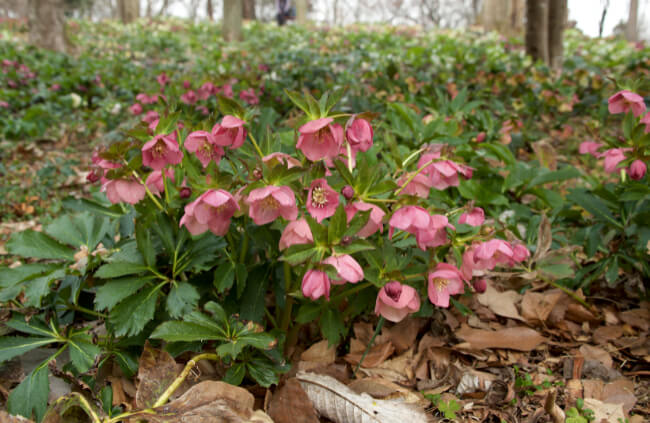
Family: | Ranunculaceae |
|---|---|
Genus: | Helleborus |
Species: | Various |
Origin: | Europe, Asia |
Common Names: | Hellebore, Winter Rose, Christmas Rose |
Location: | Outdoor |
Type: | Herbaceous perennial (some evergreen varieties) |
Growth: | 40 cm (H) x 30 cm (W) |
Sun requirements: | Shade or dappled shade |
Foliage Colour: | Green |
Flower Colour: | Whites, reds, burgundy, and near-black |
Flowering: | Winter |
Fruits: | None |
Maintenance level: | Low |
Poisonous for pets: | Toxic to cats, dogs, and horses |
What is a Hellebore?
Hellebore is the common name for a small genus of flowering herbaceous plants in the genus Helleborus. There are twenty species, each with unique traits, and hundreds of bred cultivars crossed between them.
The best hellebores for garden use are those that are hybridised and bred for that purpose, especially the more heat-resistant varieties, which tend to do best in Australian summers, provided they get enough moisture, and enough nutrition to trigger flowering in winter.
Their common name, Christmas rose is misleading for Australian gardeners as they tend to flower best in mid-winter, or Christmas time for northern hemisphere gardeners. Here, they are more generally called the winter rose.
Natural Habitat of Helleborus
Hellebores are native to Eurasia and widely spread in forest and woodland edge sites with good moisture and low, dappled, light conditions throughout the continents. They prefer changeable seasons, with wet springs and warm summers to trigger the best flowering in winter.
In their natural habitat, they can grow out in the open, or at woodland edges, where they compete with other plants, and their drainage is regulated, meaning they can grow on most soils provided they aren’t over-fed, or over-watered, but should never be allowed to dry out completely, even when they leaves die back.
Best Hellebore Varieties to Grow in Australia
While it’s quite tricky to find the right spot for hellebores in Australia, once you’ve got it in the ground, and it’s established, they require very little care. The varieties below are all tried and tested in Australian gardens and will grow even in northern states, provided they are given plenty of deep shade.
1. Hellebore ‘Single Spotted Slate’Black isn’t a colour that occurs naturally on petals. The absence of pigment tends to lead to white petals, while excessive pigmentation creates flowers like this, with stunning, near-black petals with a faint tint of purple when they catch the light. Grown in light shade in the south, or full shade in the north, these dark flowered hellebores add interest and depth to your planting. |  Source: Garden Express |
2. Hellebore ‘Single Yellow Picotee’Named for its traits, single yellow picotee, is one of my favourite hellebores, and it can cope well with summer droughts, provided you water it well in early winter then the foliage starts to shoot up again. The depth of these flowers is unrivalled in a winter garden, with deep red centres and fine burgundy markings through peach-coloured petals. What’s more, the often disappointing droop of some hellebore flowers isn’t present here, so you get full frontal flowers in early winter. |  Source: Garden Express |
3. Hellebore ‘Angel Glow’Angel glow works best in containers as they are not bred specifically for Australian gardens, but provided they have plenty of organic matter mixed into garden soil they will thrive against a south-facing, shaded wall of the house, or under dappled shade from deciduous trees. Their pastel pink flowers are just stunning in mid-winter, bringing joy to the coldest months of the year. | 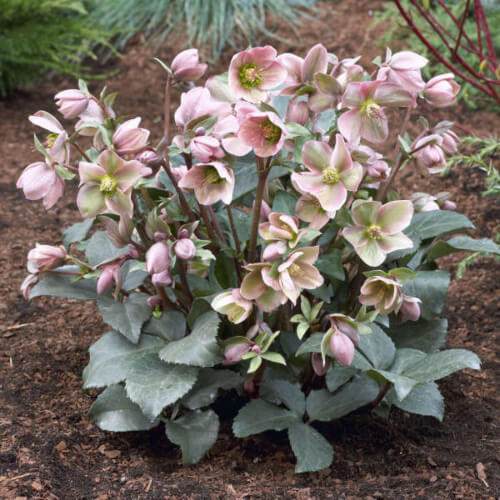 Source: Perennial Resource |
4. Hellebore ‘Double Purple’Double purple has it all. The double flowers are open enough for winter pollinators to take advantage, but ornate enough to stand out, with bright pollen-filled centres, and an elegantly dark leaf too. Even as the buds are developing, they have interest through their pale sheaths, which open into some of the deepest coloured winter flowers imaginable. | 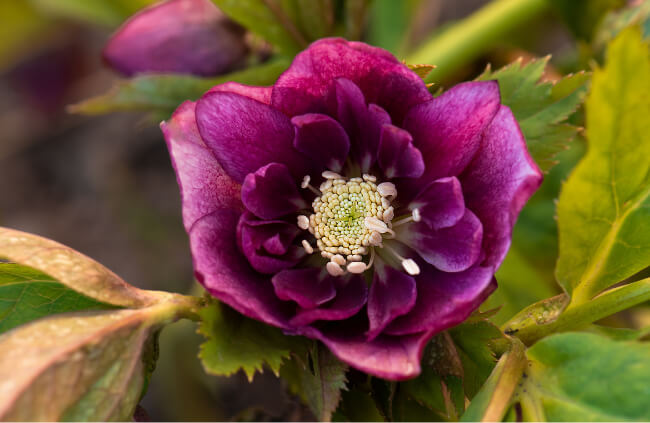 |
5. Hellebore ‘Olivia’s Joy’Olivia’s joy always reminds me of rhubarb and custard sweets. Pale, pastel yellow surrounded by a ridge of candy pink is the defining colour of this tough cultivar, which does just as well in the border as it does in a pot. With frailer leaves than most, it should be treated as deciduous, though its leaves are technically evergreen, so if it does start to look sad through the hotter summer months, just cut the foliage back and give it a generous water to trigger fresh and vigorous new growth that can cope, and feed the roots before it flowers in winter. | 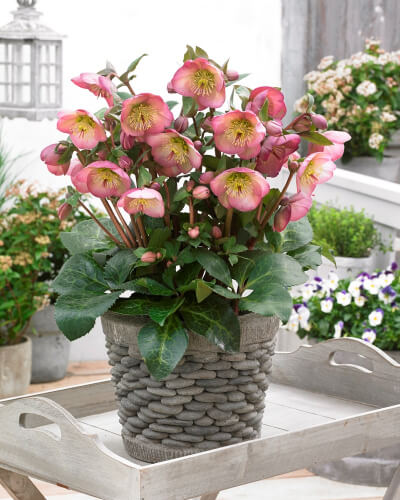 Source: Plants Management Australia |
6. Hellebore ‘Double Yellow Picotee’Double hellebores are truly special, and have more of a resemblance to the summer roses they take their name from than any other cultivar. The mass of petals creates gorgeous spiralling blooms, which last brilliantly in a vase. When they begin to flower, deadhead them right to the base, and they will continue to open in a vase on the kitchen table, and last for up to two weeks as cut flowers. |  Source: Plant Delights Nursery |
7. Hellebore ‘Double Green Spotted’Green flowers aren’t for everyone. I know that from years of pushback from gardeners who never quite believe how good lime green flowers can look, especially in a winter garden. But when it comes to hellebores, the value added by that verdant leaf is unmistakable. In winter, when your garden is looking tired, and desperate for bright blooms and lush lawns, the elegant lime green flowers of Hellebore ‘Double Green Spotted’ provide a hint of spring to come. |  Source: Reddit |
8. Hellebore ‘Tutu’Tutu is the show off of the hellebore family and it grows wonderfully in any light shade, regardless of where you are in Australia. Obviously, further north, you’ll need to water it and probably feed it through summer, but in southern Australia, it thrives with almost no care or attention. | 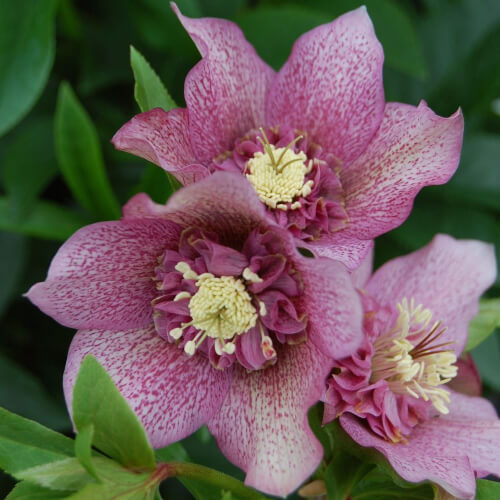 Source: Four Seasons Nursery |
9. Hellebore ‘Double Picotee’It might be a bit blousy for some, but I adore Hellebore ‘Double Picotee’. Picotee in the name, referring to its frayed colouring, bleeding down from magenta into pure white petals, with a pale coloured ring of anthers, bathed in a lime green core. Of all the hellebores I’ve ever grown, this is the one I always come back to for no other reason than to sit and stare. |  Source: The Heritage Nursery |
10. Hellebore ‘Single White Blotched’Blotched might not be a word we associate with beauty that often, but in hellebores, it indicates something really quite special. I’m a big, big, fan of foxgloves, which grow in similar conditions (dappled shade and poor soil) so this blotched cultivar, with burgundy patches, helps to extend that same colour palette from summer through into winter. Planting the two together will provide excellent succession and continued seasonal interest. | 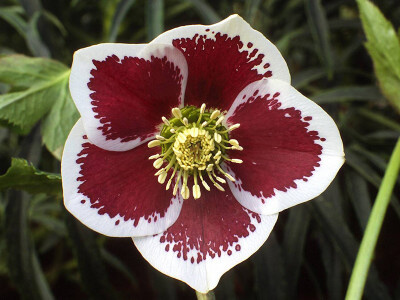 Source: Ashwood Nurseries |
11. Hellebore ‘Sophie’s Delight’Sophie’s Delight is a simple hellebore, but a popular one. Its drooping cupped flowers have just as much interest on the back of the petals as the front, meaning they can be planted in containers up high, or down on the ground. Either way, you’ll have plenty of colour as their foliage tends to be low growing, so the flowers are elevated and visible at all times. |  Source: Garden Feast |
12. Hellebore ‘Anna’s Red’Anna’s Red are one of the best lasting hellebore flowers, both in the ground, and in a vase. And, because they flower so vigorously, you’ll never notice a few flowers being cut for indoors, as the rest of the plant will continue flowering for almost two months of winter. Plant in the shade, either near a fence for a full sunscreen, or beneath deciduous fruit trees, or silver birch, whose bright white bark will really set off the deeper tones of Anna’s Red hellebore. | 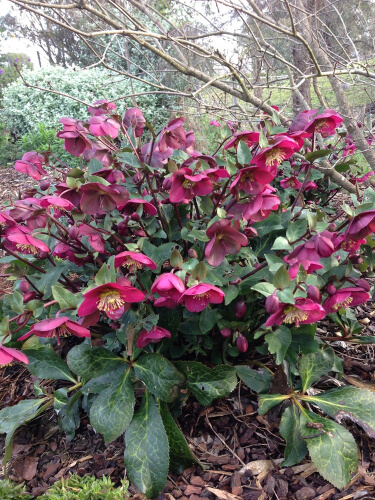 Source: Plants Management Australia |
13. Hellebore ‘Molly’s White’Molly’s white are reliably evergreen, and provided they are planted in good shade will retain their foliage right through summer. In extreme heat, it can be wise to cut back some flower stems selectively to reduce pressure on the roots, but in most cases, especially around Sydney and southern Australia, this will provide year-round interest. | 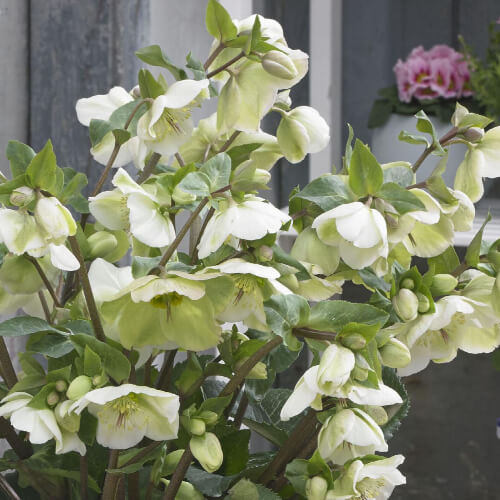 Source: Monrovia |
14. Hellebore ‘White Tutu’White tutu is my favourite of the white hellebores, simply because it offers something more than white. Its freckled petals are splashed with pink, and open out wide. To view them in their full splendour, and help the plant last through into summer with as much foliage as possible, but back the foliage above the flowers. This reveals more flowers and promotes new leaves in spring and summer. |  |
15. Hellebore ‘Isabella’s Charm’Isabella’s Charm is a stunning hellebore, if for no other reason than its flower colour. Its leaves are what really set it off though, with spectacular veining, which adds ground cover in autumn, spring and winter. In summer, its foliage will look sparse, but with a good feed and occasional water it can maintain a good evergreen form all year round, before unleashing its full performance in winter. |  Source: Southern Woods Nursery |
Best Hellebore Varieties to Grow in Australia
While it’s quite tricky to find the right spot for hellebores in Australia, once you’ve got it in the ground, and it’s established, they require very little care. The varieties below are all tried and tested in Australian gardens and will grow even in northern states, provided they are given plenty of deep shade.
1. Hellebore ‘Single Spotted Slate’

Source: Garden Express
Black isn’t a colour that occurs naturally on petals. The absence of pigment tends to lead to white petals, while excessive pigmentation creates flowers like this, with stunning, near-black petals with a faint tint of purple when they catch the light.
Grown in light shade in the south, or full shade in the north, these dark flowered hellebores add interest and depth to your planting.
2. Hellebore ‘Single Yellow Picotee’

Source: Garden Express
Named for its traits, single yellow picotee, is one of my favourite hellebores, and it can cope well with summer droughts, provided you water it well in early winter then the foliage starts to shoot up again.


Get Your Free Guide:
Master Growing Australian Natives eBook
A Must Have Complete Guide for Every Australian Garden
Get Your Free Guide:
Master Growing Australian Natives eBook
A Must Have Complete Guide for Every Australian Garden
The depth of these flowers is unrivalled in a winter garden, with deep red centres and fine burgundy markings through peach-coloured petals. What’s more, the often disappointing droop of some hellebore flowers isn’t present here, so you get full frontal flowers in early winter.
3. Hellebore ‘Angel Glow’

Source: Perennial Resource
Angel glow works best in containers as they are not bred specifically for Australian gardens, but provided they have plenty of organic matter mixed into garden soil they will thrive against a south-facing, shaded wall of the house, or under dappled shade from deciduous trees.
Their pastel pink flowers are just stunning in mid-winter, bringing joy to the coldest months of the year.
4. Hellebore ‘Double Purple’

Double purple has it all. The double flowers are open enough for winter pollinators to take advantage, but ornate enough to stand out, with bright pollen-filled centres, and an elegantly dark leaf too.
Even as the buds are developing, they have interest through their pale sheaths, which open into some of the deepest coloured winter flowers imaginable.
5. Hellebore ‘Olivia’s Joy’

Source: Plants Management Australia
Olivia’s joy always reminds me of rhubarb and custard sweets. Pale, pastel yellow surrounded by a ridge of candy pink is the defining colour of this tough cultivar, which does just as well in the border as it does in a pot.
With frailer leaves than most, it should be treated as deciduous, though its leaves are technically evergreen, so if it does start to look sad through the hotter summer months, just cut the foliage back and give it a generous water to trigger fresh and vigorous new growth that can cope, and feed the roots before it flowers in winter.
6. Hellebore ‘Double Yellow Picotee’

Source: Plant Delights Nursery
Double hellebores are truly special, and have more of a resemblance to the summer roses they take their name from than any other cultivar. The mass of petals creates gorgeous spiralling blooms, which last brilliantly in a vase.
When they begin to flower, deadhead them right to the base, and they will continue to open in a vase on the kitchen table, and last for up to two weeks as cut flowers.
7. Hellebore ‘Double Green Spotted’

Source: Reddit
Green flowers aren’t for everyone. I know that from years of pushback from gardeners who never quite believe how good lime green flowers can look, especially in a winter garden. But when it comes to hellebores, the value added by that verdant leaf is unmistakable.
In winter, when your garden is looking tired, and desperate for bright blooms and lush lawns, the elegant lime green flowers of Hellebore ‘Double Green Spotted’ provide a hint of spring to come.
8. Hellebore ‘Tutu’

Source: Four Seasons Nursery
Tutu is the show off of the hellebore family and it grows wonderfully in any light shade, regardless of where you are in Australia. Obviously, further north, you’ll need to water it and probably feed it through summer, but in southern Australia, it thrives with almost no care or attention.
9. Hellebore ‘Double Picotee’

Source: The Heritage Nursery
It might be a bit blousy for some, but I adore Hellebore ‘Double Picotee’. Picotee in the name, referring to its frayed colouring, bleeding down from magenta into pure white petals, with a pale coloured ring of anthers, bathed in a lime green core.
Of all the hellebores I’ve ever grown, this is the one I always come back to for no other reason than to sit and stare.
10. Hellebore ‘Single White Blotched’

Source: Ashwood Nurseries
Blotched might not be a word we associate with beauty that often, but in hellebores, it indicates something really quite special. I’m a big, big, fan of foxgloves, which grow in similar conditions (dappled shade and poor soil) so this blotched cultivar, with burgundy patches, helps to extend that same colour palette from summer through into winter.
Planting the two together will provide excellent succession and continued seasonal interest.
11. Hellebore ‘Sophie’s Delight’

Source: Garden Feast
Sophie’s Delight is a simple hellebore, but a popular one. Its drooping cupped flowers have just as much interest on the back of the petals as the front, meaning they can be planted in containers up high, or down on the ground.
Either way, you’ll have plenty of colour as their foliage tends to be low growing, so the flowers are elevated and visible at all times.
12. Hellebore ‘Anna’s Red’

Source: Plants Management Australia
Anna’s Red are one of the best lasting hellebore flowers, both in the ground, and in a vase. And, because they flower so vigorously, you’ll never notice a few flowers being cut for indoors, as the rest of the plant will continue flowering for almost two months of winter.
Plant in the shade, either near a fence for a full sunscreen, or beneath deciduous fruit trees, or silver birch, whose bright white bark will really set off the deeper tones of Anna’s Red hellebore.
13. Hellebore ‘Molly’s White’

Source: Monrovia
Molly’s white are reliably evergreen, and provided they are planted in good shade will retain their foliage right through summer. In extreme heat, it can be wise to cut back some flower stems selectively to reduce pressure on the roots, but in most cases, especially around Sydney and southern Australia, this will provide year-round interest.
14. Hellebore ‘White Tutu’

White tutu is my favourite of the white hellebores, simply because it offers something more than white. Its freckled petals are splashed with pink, and open out wide.
To view them in their full splendour, and help the plant last through into summer with as much foliage as possible, but back the foliage above the flowers. This reveals more flowers and promotes new leaves in spring and summer.
15. Hellebore ‘Isabella’s Charm’

Source: Southern Woods Nursery
Isabella’s Charm is a stunning hellebore, if for no other reason than its flower colour. Its leaves are what really set it off though, with spectacular veining, which adds ground cover in autumn, spring and winter.
In summer, its foliage will look sparse, but with a good feed and occasional water it can maintain a good evergreen form all year round, before unleashing its full performance in winter.
How to Grow Hellebores in Australia
Hellebores have a long flowering period, and while most are deciduous, evergreen varieties tend to grow best in Australia as their leaves help to shade the roots in summer, and reduce the need for watering.
The basic rules of hellebore care are;
- Provide shade (deep is best, but dappled is ok)
- Water lightly, not deeply
- Divide, divide, divide
Growing Hellebores in Pots

Hellebores can be grown in pots, and in some cases will do much better in those conditions. While they quite like a bit of competition, growing shade-loving, drought-tolerant plants in Australia does often mean quite a bit of experimentation.
So, if you want to see where your hellebores are happy, plant them into plastic containers, and place them around the garden. If they’re happy in the pots, you can plant them out the following year.
Start with a mix of 50% organic compost, and 5% garden soil. Sieve both, and mulch over the surface after planting hellebores to retain moisture and reduce the need for watering. Position your pot somewhere with good shade, and tidy up any brown leaves occasionally.
How to Grow Hellebores in a Shady Spot
If you prefer to let your garden do the work for you, then plant your hellebores directly into the ground in a shady spot. They will benefit from compost when you first plant them but use it as a mulch rather than digging it through. This will just help to protect them from any extreme weather for a few months, as well as gently feeding the roots.
Plant hellebores in late summer to mid-autumn when days are starting to get shorter and the temperatures are slightly cooling as this will give them enough time to establish and perform to their best in their first winter.

Soil and drainage
Hellebores don’t mind poor soil, so you can plant them in anything really. I usually dig through a patch of ground, making sure it’s loose enough for their vigorous roots to establish quickly, and then plant directly into it, but for very sandy conditions, it can be worth adding a few handfuls of compost to hold moisture.
In clay conditions, hellebores seem to do reasonably well, but add a good mulch of soil improver every year until worms work it in and you’ve got a more open, better-drained spot.
Water requirements
Hellebores are drought tolerant, and are largely dormant in summer, just quietly photosynthesising and feeding themselves, ready for winter. In extreme conditions, water evergreen hellebores once a week to prevent them from completely drying out, but they shouldn’t need much water if they are planted in the ground through winter.
Soil pH
Most gardens in Australia will have a soil pH of around 6.0 to 7.0, meaning slightly acidic. Hellebores actually prefer alkaline soil, but only very slightly (7.0 to 8.0). Add wood ash or lime to your soil when planting, or every couple of years until the pH improves.
Light requirements
Shade. Hellebores need shade, and will never enjoy being out in full sun. Dappled shade is ok, but they really don’t need anything more than 2-3 hours of direct light per day, so anything out in the open with 6 hours or more of direct sun won’t work.
How to Propagate Hellebores
Hellebores are expensive plants for a very simple reason – they take a long time to grow, and even longer to breed. So while it is possible to grow hellebores from seed, unless you’ve got a very, very big garden, with space to spare for a few years, the best way to make new hellebore plants is by dividing your existing plants.
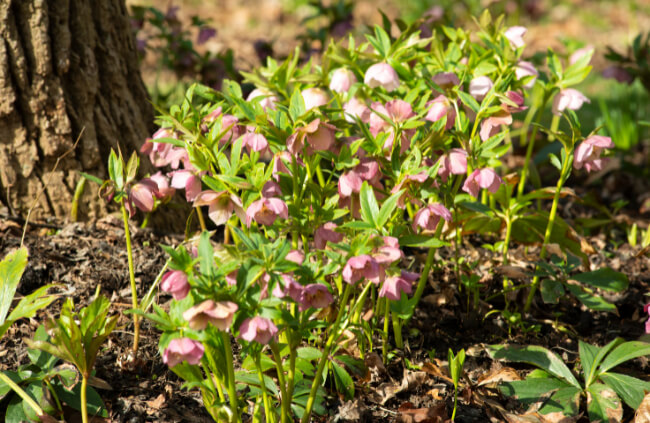
Dividing hellebores couldn’t be easier. All you need is a spade, a kitchen knife, and a good spot to plant them into.
- Start by digging up a clump of hellebores. Anything over 25 cm across can be divided in two, but never reduce clumps by more than two-thirds, and make sure each division is about 15 cm across.
- Once dug out, cut down the middle of the plant, between flowering stems, or leaf shoots. Once you’ve made the initial cut, it should be quite simple to pull the two halves apart.
- Quickly plant each clump back into the ground, with one in its original spot, and the other in similar conditions to avoid shock.
- Fill in any empty space with garden compost, and soak both clumps.
- If you do this in spring or early summer, both should flower well next winter.
Caring for Hellebores in Winter
While flowering, there is nothing you need to do, but there are things you can do to improve the appearance of your hellebores. One common practice, particularly for gardeners who like to keep their garden looking absolutely pristine, is to cut back the foliage of hellebores during flowering, leaving just the flower spikes.
This will put more of a focus on the temporary flowers, and encourage fresh new leaves for summer ground cover. Other than that, the only other care you should give to your hellebores is a light mulch of garden compost every two years at the end of winter or when they finish flowering to help feed to soil.
Common Hellebore Pests and Diseases
Hellebores are generally pest and disease free in Australia, but root rot will kill them if they are overwatered, and over-feeding can produce lazy plants that become infected with fungal leaf spots.
If you ever notice leaf spots on your hellebores, simply cut away the affected leaves and burn them, or put them in your normal waste bin to avoid spreading the infection. Reduce watering and they should recover well.
In terms of pests, hellebores are slug and snail resistant, and flowers earlier than most garden pests are active, but if you do choose to cut foliage back to elevate the flowers in winter, the new spring growth can be infested with aphids.
Spray them off with a strong hose jet, or just cut the infested leaf off and discard it. Refer to our complete guide on how to deal with aphids.
Frequently Asked Questions About Hellebores
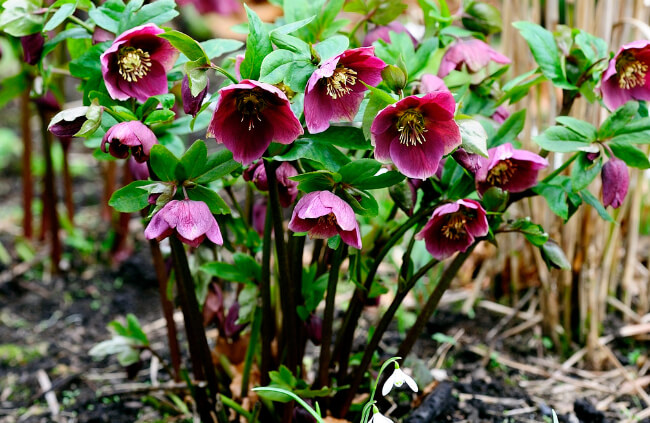
Do hellebores flower all year?
Hellebores flower from mid-winter through to mid-spring and brighten up dark shady corners really well for that reason. When you buy hellebores in garden centres, they are usually on display from mid-autumn, and often in flower, but don’t be fooled. It’s nice to see before you buy, but they won’t flower at that time again.
What do you do with hellebores in the summer?
Deciduous hellebores should be cut back to the ground after flowering, but by choosing evergreen varieties, you’ll be rewarded with elegant ground cover through spring, summer, and autumn, with nothing to do but watch and wait.
Do hellebores spread quickly?
Hellebores are slow growing, and spread slowly too. Individual plants will spread out to about two feet wide after 3-5 years, by which point you can divide them and encourage new clumps.
Wrapping Up Our Hellebores Growing and Caring Guide
I adore hellebores, and everything about them. Their leaves, their flowers, their anthers, and the way they stand tall when everything around them is crying out for summer. They also make a wonderful addition to parts of the garden that are all too often forgotten about.
So make the most of your shady borders, and grow these stunning winter roses at home. Growing hellebores isn't hard, provided you find the right conditions to begin with.
Published on June 12, 2023 by Maisie Blevins
Last Updated on February 23, 2025




